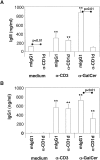CD1d-restricted help to B cells by human invariant natural killer T lymphocytes
- PMID: 12695492
- PMCID: PMC2193881
- DOI: 10.1084/jem.20021616
CD1d-restricted help to B cells by human invariant natural killer T lymphocytes
Abstract
Invariant natural killer T (NKT) cells are a highly conserved subset of T lymphocytes expressing a semi-invariant T cell receptor (TCR), which is restricted to CD1d and specific for the glycosphingolipid antigen alpha-galactosylceramide. Their ability to secrete a variety of cytokines, which in turn modulate the activation of cells of both innate and acquired immune responses, suggests that invariant NKT cells exert a regulatory role mainly via indirect mechanisms. A relevant question is whether invariant NKT cells can directly help B cells. We document here that human invariant NKT cells are as efficient as conventional CD4+ Th0 lymphocytes in promoting proliferation of autologous memory and naive B lymphocytes in vitro, and in inducing immunoglobulin production. Help to B cells by invariant NKT cells is CD1d-dependent and delivered also in the absence of alpha-galactosylceramide, suggesting that NKT cells recognize an endogenous ligand presented by CD1d on B cells. The two major subsets of invariant NKT cells, CD4+ and double negative (CD4-CD8-), express comparable levels of CD40 ligand and cytokines, but differ in helper functions. Indeed, both subsets induce similar levels of B cell proliferation, whereas CD4+ NKT cells induce higher levels of immunoglobulin production. These results suggest a direct role for invariant NKT cells in regulating B lymphocyte proliferation and effector functions.
Figures




References
-
- Kronenberg, M., and L. Gapin. 2002. The unconventional lifestyle of NKT cells. Nat. Rev. Immunol. 2:557–568. - PubMed
-
- Bendelac, A., M.N. Rivera, S.H. Park, and J.K. Roark. 1997. Mouse CD1d-specific NK1.1+ T cells. Development, specificity, and function. Annu. Rev. Immunol. 15:535–562. - PubMed
-
- Porcelli, S.A., and R.L. Modlin. 1999. The CD1d system: antigen presenting molecules for T cell recognition of lipids and glycolipids. Annu. Rev. Immunol. 17:297–329. - PubMed
Publication types
MeSH terms
Substances
LinkOut - more resources
Full Text Sources
Other Literature Sources
Research Materials

